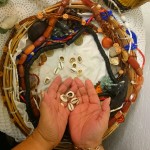 Divination systems have been around since time immemorial. From the I Ching to the Tarot, everyone who has a strong connection to Spirit somehow finds their way to one divination system or another. One such divination system that’s not very well-known to the rest of the world is the art of cowrie shell reading.
Divination systems have been around since time immemorial. From the I Ching to the Tarot, everyone who has a strong connection to Spirit somehow finds their way to one divination system or another. One such divination system that’s not very well-known to the rest of the world is the art of cowrie shell reading.
This divination art is often found and associated with the Afro-Caribbean and Afro-Brazilian religions, one of which is Candomble, a religion founded in Brazil around the 19th century when the first terreiro, or temple, was first built.
Interestingly, each variation of the more well-known African-based religions has its own distinct form of cowrie shell divination, and each variant uses a different number of shells. But the most commonly-used number is 16, or “Merindinlogun,” roughly meaning “4 from 20.”
How Cowrie Shell Divination Works
This is not all that common a divination form amongst Caucasians, so common information on this method is somewhat difficult to find. That being said, there are two main reasons why you’d want the cowrie shells thrown.
To Find Out Who Your Protective Orisha Is. If you are a Candomble practitioner, or perhaps a practitioner of another similar religion, you can ask someone initiated into the religion, as well as the art of cowrie shell divination who your tutelary/protective orisha is.
To Simply Ask Questions of the Orishas. Many Candomble practitioners go to temple to have their fortunes read. Even though there are 16 shells used, there are likely many possible “odu” or patterns. It is believed that when you throw the cowrie shells, the orishas, also thought of as nature gods, influence how they appear on the divination space. In Candomble, interpreting the shells is a matter of whether the shell slit is up, or “open” or the shell slit is down, or “closed.” The number of “open” shells is used to determine the odu, or pattern meaning, which is associated with a particular oracular verse.
In this sense, such a method is very different from the usual divination methods out there because Candomble has no sacred books to speak of, no guidebooks to help the beginner. The entire tradition is oral, and it’s believed you are either called to read the shells or not.
That said, cowrie shell reading, though little-known as it is, happens to be one of the most fascinating forms of divination, and unlike the way many people view the Tarot, cowrie shell divination is treated by its practitioners as very sacred.
